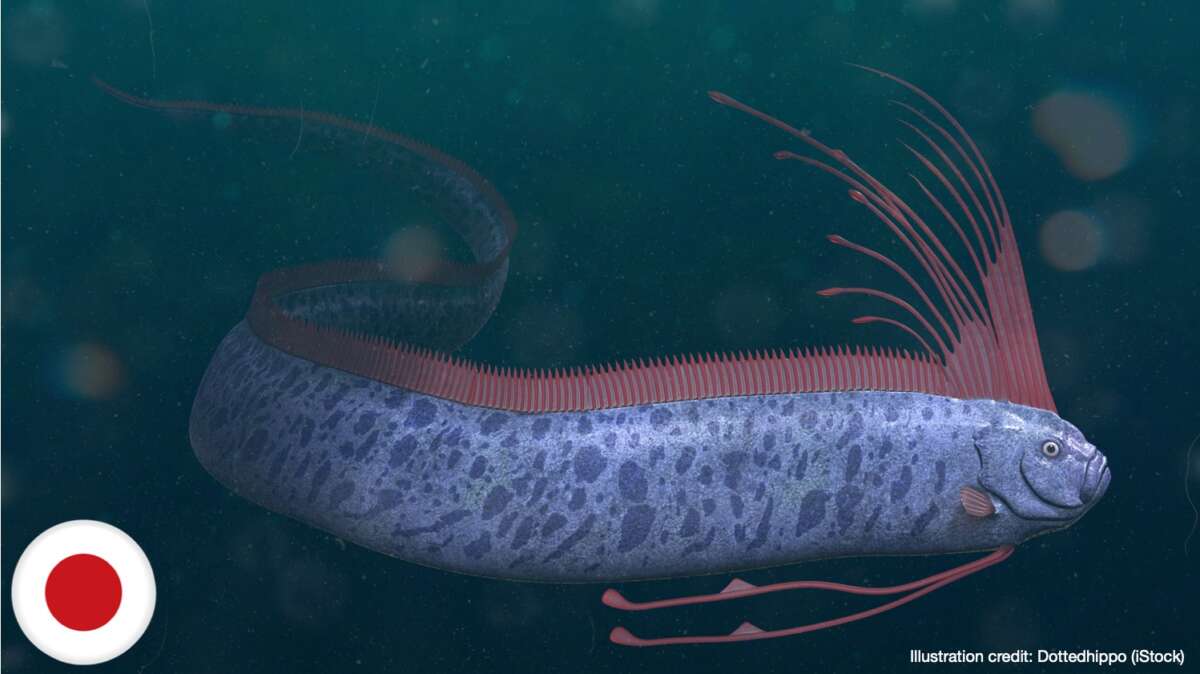Welcome to my visitors from Nippon. In this post, I will be discussing the recent encounter with an oarfish (Namazu) which are thought to be ryugu no tsukai and the legend, history and science concerning these mysterious but magnificent creatures. In the past, the beaching of oarfish have been thought to precede earthquakes, tsunamis or other natural misfortune.
The sightings
On July 15, 2023 divers off the coast of Taiwan noted an oarfish just over two meters long swimming close to the surface of the ocean. Oarfish can grow eight times that length during its lifespan. This specimen had unusual holes in its body which resembled the bite marks of a cigar shark. Thus, while it was alive, it was not thought to be healthy. In fact, such oarfish seldom rise above 200 meters, preferring to live much deeper than that. For this reason, they are seldom seen by people. Nor can they survive close to the surface. At the depths they live in, there are no water currents so the Namazu have evolved with very weak muscles if they have muscles at all. There are times when they emerge from the ocean and these appearances have traditionally been though to be harbingers of disaster, specifically earthquakes and the tsunamis that are caused by the tremors. For this reason, Japanese have called these fish “the messengers from the sea dragon god’s palace” warning Japan of an impending disaster.
The legend
According to the National Herald of India, The Namazu is considered one of the ‘yo-kai’, the creatures of mythology which cause misfortune.” But not every country agrees. China believe that the appearance of Namazu is a lucky sign, while in Korea it is often given as a gift to newlyweds.

We know more about the sea god and his palace from Japanese fairy tales, such as otogi banashi. Someone named Urashima Tarō was a hero in this very story. As retold today, he rescues a turtle being torment by some children and he releases it into the sea. The next day a huge turtle appears to tell him that the turtle he saved is actually the daughter of Ryūjin, Emperor of the Sea who wishes to personally thank Urashima Tarō. While at the palace, Urashima Tarō is entertained by the princess Otohime for what seems to be several days. Urashima Tarō asks to return home because his mother is very old, and his wish is granted. Before he leaves the palace, he is given a special box from Otohime that she says will protect him, but he must never open the box. When he returns to his village, his mother is long departed and his name is just a faint memory because he finds that he has been gone for not for only three days, but for one hundred years! In his grief and shock, he opens the box he has been given without thinking and is immediately transformed into an old man. Parts of this tale date back to the eighth century and there are some differences in the versions that exist today.
The oarfish were believed to live under the islands of Japan and emerged or were sent by the sea god to warn people when they were in danger.
The history
Some people today claim what when you find oarfish on a shore, a disaster is sure to soon follow:
“Shortly before the 2011 Tohoku earthquake and tsunami struck Japan, about 20 oarfish stranded themselves on beaches in the area, Mark Benfield, a researcher at Louisiana State University, told LiveScience in an earlier interview.” Also, “. . . Dozens of the deep-sea denizens were discovered by Japanese fishermen around the time a powerful 8.8-magnitude earthquake struck Chile in March 2010.”

The Tohoku tsunami, itself “produced waves up to 40 meters (132 feet) high, More than 450,000 people became homeless as a result of the tsunami. More than 15,500 people died. The tsunami also severely crippled the infrastructure of the country.” The Tohoku earthquake was the most powerful in Japan’s recorded history.
The science
In spite of all of this empirical evidence, there is very little science to the relationship between oarfish sightings and disaster:
“A group of Japanese researchers reviewed different sources in order to find a correlation between oarfish sightings and earthquakes. In order to do this, they compiled information from newspapers reports, academic articles and aquarium records dated from November 1928 to March 2011. From this information, they determined that the total number of deep-sea fish appearances was 392, from a total of 45 species. From this 45, only 8 species, including the oarfish Regalecus glesne are associated with earthquakes. They compared 336 deep-sea appearances with 221 earthquakes that happened during that period of time by applying statistical methods, but they were unable to find a correlation. First of all, no deep-sea fish were sighted before the occurrence of an earthquake with a magnitude of 7.0 or higher. Additionally, no earthquakes with a magnitude of 6.0 or higher were reported despite the sighting of 30 deep-sea fishes between January and February 2010. These results not only oppose the legend, but they also confirm that the appearances of deep-sea fish are not useful information for disaster mitigation.”
It is possible that the Namazu can sense minor tremors coming from the sea floor in the same way that animals can. One of the earliest accounts of this is also a very interesting one.
“One famous instance is recorded in the history of Helike, an ancient Greek city. During the winter of 373 B.C., “all the mice and martens and snakes and centipedes and beetles and every other creature of that kind in the city left,” wrote the Roman author Aelianus. “After these creatures had departed, an earthquake occurred in the night; the city subsided; an immense wave flooded and Helike disappeared.”
Also disappearing with the city were ten ships from Sparta which were docked in the harbor at the time.
Other theories about why these fish emerge deal with changes in the salinity and temperature of the waters. But for now, we just don’t know.





